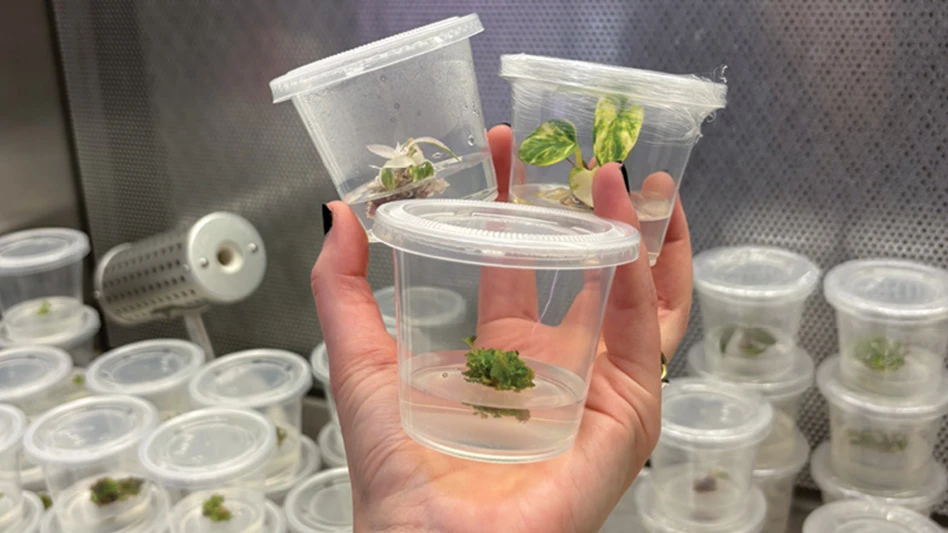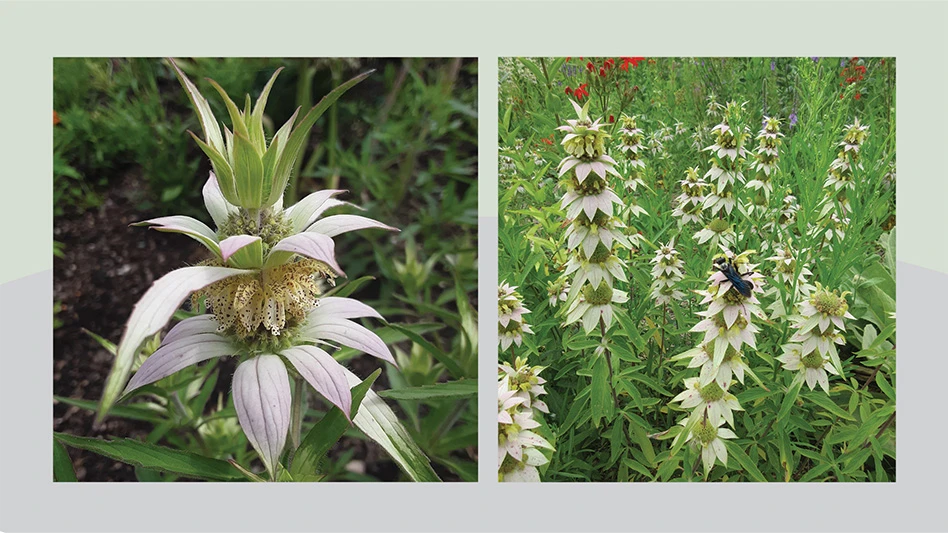 Leanne Pundt Leanne Pundt |
Growers easily recognize the symptoms of rust diseases, but once they become established, rusts can be difficult to control. The common name “rust” refers to the characteristic reddish to orange blister-like swellings (also known as “pustules”) that are produced on infected leaves and stems of host plants. The fungi that cause rust diseases are obligate parasites that need living plants to survive. So, they seldom kill plants but reduce overall plant health. If infections are severe, leaf blighting and premature drop may occur. Unlike most fungi that produce only one or two types of spores on a single host, rust fungi have a more complicated life cycle. For some rusts, only one host is needed. For others, two different types of hosts are needed for the pathogen to complete its life cycle. Among some common alternate hosts of rusts of ornamentals are conifers and grasses.
Rust diseases can affect a wide range of ornamental hosts including aster, campanula, carnation, chrysanthemum, daylily, fuchsia, goldenrod, hollyhock, iris, marigold, penstemon, poinsettia, rose, snapdragon, switchgrass, statice, veronica, violet and zonal or bedding geranium. Here’s an overview of a few of these rust diseases. Chrysanthemum brown rust is caused by Puccinia tanaceti and results in yellow spots on the upper leaf surface. As the disease progresses, chocolate-brown rust pustules develop on the underside of the leaves. Chrysanthemum white rust (CWR) is caused by Puccinia horiana, which is a federally regulated, quarantined plant pathogen. Its common name refers to the diagnostic pustules that develop on the underside of the leaves — they are first white, and then turn pinkish or buff-colored as they age. Symptoms first begin as yellow to tan spots on the upper surface of leaves. Infected plants may not show any symptoms during hot dry conditions, but only when the weather turns cool and wet. In recent years, this disease has had a severe impact on hardy mum growers in the Northeast and West Coast. Hollyhock rust is caused by the fungus Puccinia malvaracearum. Symptoms include yellow spots on the upper leaf surface and orange brown pustules on the underside of the leaves and occasionally on the stems. Heavily infected leaves are killed and plants become unattractive. This rust also occurs on mallow, a common weed, which can serve as a reservoir of hollyhock rust. Fuchsia rust is caused by the fungus Pucciniastrum epilobi. Affected leaves may be deformed and defoliation often occurs. Look for bright orange pustules on the underside of the leaves. This disease can be especially severe during propagation, so it may be spread on infected cuttings. This rust also occurs on fireweed, which can serve as a reservoir of inoculum. To complete its cycle, Fuchsia rust must rotate from fireweed and fuchsia to its alternate hosts, true fir. Geranium rust is caused by the fungus Puccinia pelargoni-zonalis and affects zonal or bedding geraniums. This fungus completes its life cycle on one host. Rust resistance has been found in the regal, scented and ivy leaf geraniums. Initial symptoms appear as chlorotic specks on the upper leaf surface. Pustules containing rust-colored spores erupt in concentric rings that form a distinct “target” spot on the underside of the leaves. Purchase certified, culture-indexed cuttings to help prevent this rust disease that can be spread on infected cuttings. Discard unwanted geraniums at the end of the growing season. Switchgrass rust is caused by Puccinia emaculata and can be especially severe on susceptible cultivars of switchgrass such as Dallas Blues, Dewey Blues, Cloud Nine and Northwind. Elongate, narrow, rust-colored pustules form on the leaves, which are followed by browning and drying of infected leaves. Veronica rust is caused by Puccinia veronicare longifloliae and has been observed on Veronica longifolia "Eveline" and Veronica spicata. Symptoms include reddish-brown necrotic sunken spots with a faint yellow margin on the upper leaf surface, and reddish-brown to tan pustules on the underside of the leaves. Heavy infections can result in defoliation.
Scout regularly for rust diseases on susceptible plants or cultivars. Look on the upper leaf surface for chlorotic specks and on the underside of the leaves for the characteristic pustules that develop on that particular host plant. Watch carefully for the beginnings of rust outbreaks, so your treatments can be effective. Once detected, remove all rust-infected leaves and heavily infected plants by carefully placing them in a plastic bag before removing them from the greenhouse. Rust spores are easily spread in air currents. Destroy infected plant material by burning, rapid-composting or burying. Reducing leaf wetness helps to prevent rust development. Keep foliage dry by proper watering practices and environmental controls. Space plants so there is good air circulation. Select less-susceptible cultivars, whenever possible. See references below for additional information. There are a number of different fungicides that are effective against rust diseases. If you have a re-occuring history of a problem with a particular rust disease on certain plants or cultivars, preventive applications are helpful. Rotate applications between chemical classes or FRAC codes to help prevent fungicide resistance from developing. Use contact fungicides in rotation with systemic fungicides. Heritage and other strobilurins are especially effective for rusts. Protectant fungicides such as mancozeb are also helpful. Fungicides in the demethylation inhibitor (DMI) category can also be effective and include Strike, Terraguard and Eagle. Propiconazole (Banner MAXX) is labeled for outdoor uses. SuffOil X, traditionally used for insect and mite control, is also labeled for rusts and may help smother rust spores. At the end of the season, carefully clean up and destroy all infected crop debris. Use a commercially available disinfectant to clean up the growing area. To avoid any potential phytotoxicity problems, spot test first before widespread use. No discrimination is intended for any products not listed.
Leanne Pundt is extension educator at the University of Connecticut.
|

Explore the July 2012 Issue
Check out more from this issue and find your next story to read.
Latest from Greenhouse Management
- New book explores plants that thrive in Rocky Mountains
- Prospiant appoints Burk Metzger as new president
- Iowa plant supplier Plantpeddler building retail complex
- American Floral Endowment establishes Herman Meinders Memorial Tribute
- These companies are utilizing plastic alternatives to reduce horticultural waste
- Terra Nova releases new echinacea variety, 'Fringe Festival'
- AmericanHort expands greenhouse training with new Section Grower Certification
- Sakata Seed America celebrates renovation of Cal Poly greenhouse complex

 Symptoms
Symptoms






